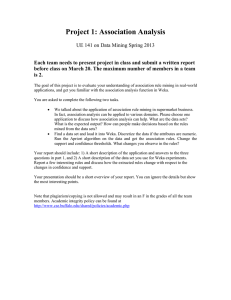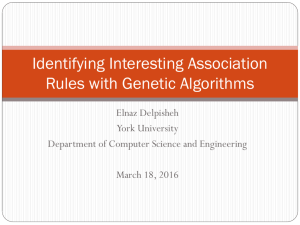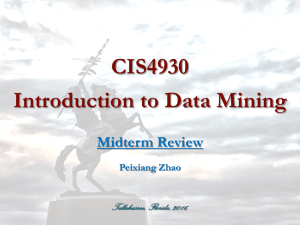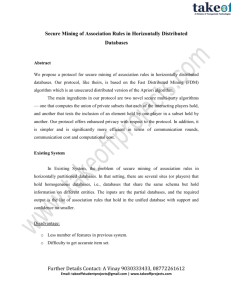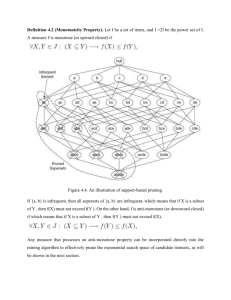Using Apriori with WEKA for Frequent Pattern Mining Paresh Tanna
advertisement
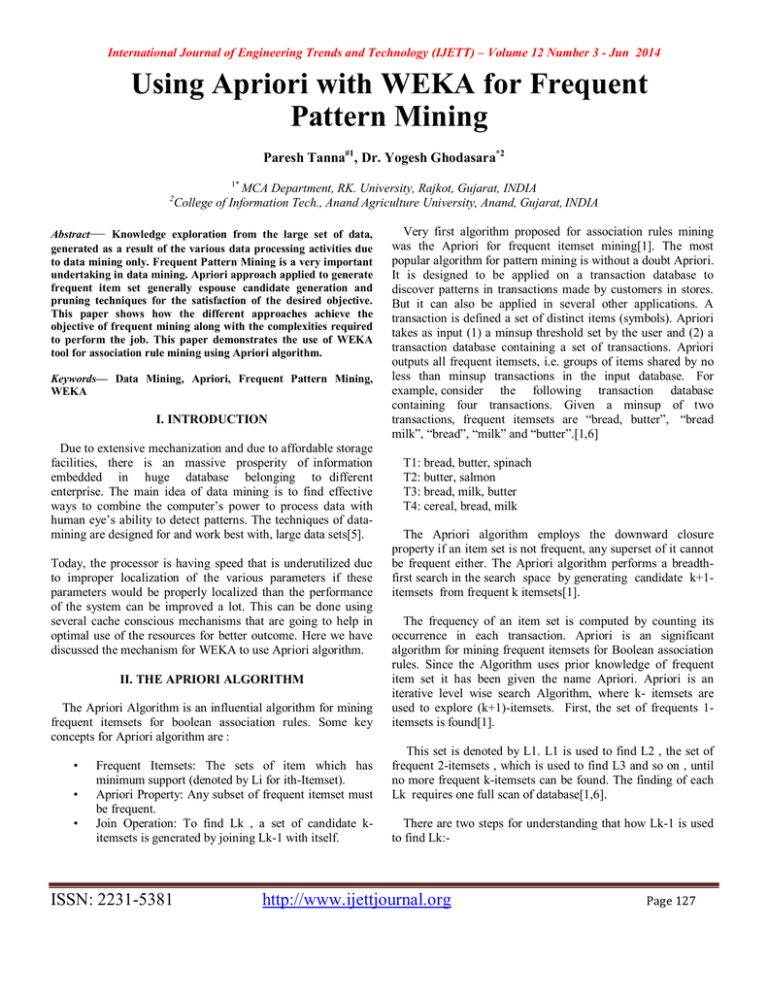
International Journal of Engineering Trends and Technology (IJETT) – Volume 12 Number 3 - Jun 2014
Using Apriori with WEKA for Frequent
Pattern Mining
Paresh Tanna#1, Dr. Yogesh Ghodasara*2
1*
2
MCA Department, RK. University, Rajkot, Gujarat, INDIA
College of Information Tech., Anand Agriculture University, Anand, Gujarat, INDIA
Abstract— Knowledge exploration from the large set of data,
generated as a result of the various data processing activities due
to data mining only. Frequent Pattern Mining is a very important
undertaking in data mining. Apriori approach applied to generate
frequent item set generally espouse candidate generation and
pruning techniques for the satisfaction of the desired objective.
This paper shows how the different approaches achieve the
objective of frequent mining along with the complexities required
to perform the job. This paper demonstrates the use of WEKA
tool for association rule mining using Apriori algorithm.
Keywords— Data Mining, Apriori, Frequent Pattern Mining,
WEKA
I. INTRODUCTION
Due to extensive mechanization and due to affordable storage
facilities, there is an massive prosperity of information
embedded in huge database belonging to different
enterprise. The main idea of data mining is to find effective
ways to combine the computer’s power to process data with
human eye’s ability to detect patterns. The techniques of datamining are designed for and work best with, large data sets[5].
Today, the processor is having speed that is underutilized due
to improper localization of the various parameters if these
parameters would be properly localized than the performance
of the system can be improved a lot. This can be done using
several cache conscious mechanisms that are going to help in
optimal use of the resources for better outcome. Here we have
discussed the mechanism for WEKA to use Apriori algorithm.
II. THE APRIORI ALGORITHM
The Apriori Algorithm is an influential algorithm for mining
frequent itemsets for boolean association rules. Some key
concepts for Apriori algorithm are :
•
•
•
Frequent Itemsets: The sets of item which has
minimum support (denoted by Li for ith-Itemset).
Apriori Property: Any subset of frequent itemset must
be frequent.
Join Operation: To find Lk , a set of candidate kitemsets is generated by joining Lk-1 with itself.
ISSN: 2231-5381
Very first algorithm proposed for association rules mining
was the Apriori for frequent itemset mining[1]. The most
popular algorithm for pattern mining is without a doubt Apriori.
It is designed to be applied on a transaction database to
discover patterns in transactions made by customers in stores.
But it can also be applied in several other applications. A
transaction is defined a set of distinct items (symbols). Apriori
takes as input (1) a minsup threshold set by the user and (2) a
transaction database containing a set of transactions. Apriori
outputs all frequent itemsets, i.e. groups of items shared by no
less than minsup transactions in the input database. For
example, consider the following transaction database
containing four transactions. Given a minsup of two
transactions, frequent itemsets are “bread, butter”, “bread
milk”, “bread”, “milk” and “butter”.[1,6]
T1: bread, butter, spinach
T2: butter, salmon
T3: bread, milk, butter
T4: cereal, bread, milk
The Apriori algorithm employs the downward closure
property if an item set is not frequent, any superset of it cannot
be frequent either. The Apriori algorithm performs a breadthfirst search in the search space by generating candidate k+1itemsets from frequent k itemsets[1].
The frequency of an item set is computed by counting its
occurrence in each transaction. Apriori is an significant
algorithm for mining frequent itemsets for Boolean association
rules. Since the Algorithm uses prior knowledge of frequent
item set it has been given the name Apriori. Apriori is an
iterative level wise search Algorithm, where k- itemsets are
used to explore (k+1)-itemsets. First, the set of frequents 1itemsets is found[1].
This set is denoted by L1. L1 is used to find L2 , the set of
frequent 2-itemsets , which is used to find L3 and so on , until
no more frequent k-itemsets can be found. The finding of each
Lk requires one full scan of database[1,6].
There are two steps for understanding that how Lk-1 is used
to find Lk:-
http://www.ijettjournal.org
Page 127
International Journal of Engineering Trends and Technology (IJETT) – Volume 12 Number 3 - Jun 2014
1) The join step : To find Lk , a set of candidate k-itemsets is
generated by joining Lk-1 with itself . This set of
candidates is denoted Ck.
2) The prune step: Ck is a superset of Lk , that is , its
members may or may not be frequent , but all of the
frequent k-itemsets are included in Ck .
A scan of the database to determine the count of each
candidate in Ck would result in the determination of Lk. Ck,
however, can be huge, and so this could involve heavy
computation.
To reduce the size of Ck , the Apriori property is used as
follows.
i.
Any (k-1)-item set that is not frequent cannot be a
subset of frequent k-item set.
ii.
Hence, if (k-1) subset of a candidate k item set is not
in Lk-1 then the candidate cannot be frequent either
and so can be removed from C.
Based on the Apriori property that all subsets of a frequent
itemset must also be frequent, we can determine that four latter
candidates cannot possibly be frequent. How ?
For example, let’s take {I1, I2, I3}. The 2-item subsets of it
are {I1, I2}, {I1, I3} & {I2, I3}. Since all 2-item subsets of {I1,
I2, I3} are members of L2, We will keep {I1, I2, I3} in C3.
Let’s take another example of {I2, I3, I5} which shows how
the pruning is performed. The 2-item subsets are {I2, I3}, {I2,
I5} & {I3,I5}.
BUT, {I3, I5} is not a member of L2 and hence it is not
frequent violating Apriori Property. Thus We will have to
remove {I2, I3, I5} from C3.
Therefore, C3 = {{I1, I2, I3}, {I1, I2, I5}} after checking for
all members of result of Join operation for Pruning.
Apriori algorithm pseudo code:
procedure Apriori (T, minSupport)
{ //T is the database and minSupport is the minimum support
L1= {frequent items};
for (k= 2; Lk-1 !=∅; k++)
{
Ck= candidates generated from Lk-1
//that is cartesian product Lk-1 x Lk-1 and
//eliminating any k-1 size itemset that is not
//frequent
for each transaction t in database do
{
ISSN: 2231-5381
#increment the count of all candidates in Ck
that are contained in t
Lk = candidates in Ck with minSupport
}//end for each
}//end for
return ;
}
Association rule generation is usually split up into two
separate steps:
1.
First, minimum support is applied to find all frequent
itemsets in a database.
2. Second, these frequent itemsets and the minimum
confidence constraint are used to form rules.
While the second step is straight forward, the first step needs
more attention. Finding all frequent itemsets in a database is
difficult since it involves searching all possible itemsets (item
combinations).
The set of possible itemsets is the power set over I and has
size 2n − 1 (excluding the empty set which is not a valid
itemset). Although the size of the powerset grows exponentially
in the number of items n in I, efficient search is possible using
the downward-closure property of support (also called antimonotonicity) which guarantees that for a frequent itemset, all
its subsets are also frequent and thus for an infrequent itemset,
all its supersets must also be infrequent. Exploiting this
property, efficient algorithm (e.g., Apriori) can find all frequent
itemsets. As is common in association rule mining, given a set
of itemsets (for instance, sets of retail transactions, each listing
individual items purchased), the algorithm attempts to find
subsets which are common to at least a minimum number
min_sup of the itemsets. Apriori uses a "bottom up" approach,
where frequent subsets are extended one item at a time (a step
known as candidate generation), and groups of candidates are
tested against the data[6].
The algorithm terminates when no further successful
extensions are found. Apriori uses breadth-first search and a
tree structure to count candidate item sets efficiently. It
generates candidate item sets of length k from item sets of
length k − 1. Then it prunes the candidates which have an
infrequent sub pattern.
According to the downward closure lemma, the candidate set
contains all frequent k-length item sets. After that, it scans the
transaction database to determine frequent item sets among the
candidates.
Apriori, while historically significant, suffers from a number
of inefficiencies or trade-offs, which have spawned other
algorithms. Candidate generation generates large numbers of
http://www.ijettjournal.org
Page 128
International Journal of Engineering Trends and Technology (IJETT) – Volume 12 Number 3 - Jun 2014
subsets (the algorithm attempts to load up the candidate set
with as many as possible before each scan).
Bottom-up subset exploration (essentially a breadth-first
traversal of the subset lattice) finds any maximal subset S only
after all 2 | S | − 1 of its proper subsets.
III. SAMPLE USAGE OF ASSOCIATION RULE
MINING IN WEKA:
For our test we shall consider 15 transactions that have made
for a shopping center. Each transaction has specific list of
items. Here we have demonstrated use of Apriori algorithm
for association rule mining using WEKA[8]. The ARFF file
presented bellow contains information regarding each
transaction’s items detail.
TRUE,TRUE,TRUE,TRUE,FALSE,FALSE,TRUE,TRUE
TRUE,TRUE,TRUE,TRUE,TRUE,TRUE,FALSE,TRUE
FALSE,TRUE,TRUE,TRUE,FALSE,FALSE,FALSE,TRUE
FALSE,TRUE,FALSE,FALSE,TRUE,FALSE,TRUE,TRUE
TRUE,TRUE,FALSE,TRUE,TRUE,FALSE,TRUE,TRUE
TRUE,FALSE,TRUE,FALSE,FALSE,TRUE,TRUE,TRUE
FALSE,TRUE,FALSE,TRUE,TRUE,FALSE,TRUE,TRUE
TRUE,FALSE,TRUE,TRUE,TRUE,FALSE,TRUE,TRUE
FALSE,TRUE,TRUE,TRUE,TRUE,FALSE,FALSE,TRUE
TRUE,FALSE,TRUE,FALSE,TRUE,TRUE,FALSE,TRUE
FALSE,FALSE,TRUE,FALSE,TRUE,FALSE,FALSE,TRUE
TRUE,FALSE,FALSE,TRUE,TRUE,TRUE,FALSE,TRUE
FALSE,TRUE,TRUE,FALSE,TRUE,TRUE,FALSE,TRUE
TRUE,TRUE,TRUE,FALSE,FALSE,TRUE,FALSE,TRUE
TRUE,TRUE,FALSE,FALSE,TRUE,TRUE,FALSE,TRUE
Transaction table:
--Trans
ID
1
Items
A,B,C,D,G,H
2
A,B,C,D,E,F,H
3
B,C,D,E,H
4
B,E,G,H
5
A,B,D,E,G,H
6
A,C,F,G,H
7
B,D,E,G,H
8
A,C,D,E,G,H
9
B,C,D,E,H
10
A,C,E,F,H
11
C,E,H
12
A,D,E,F,H
13
B,C,E,F,H
14
A,B,C,F,H
15
A,B,E,F,H
Using the Apriori Algorithm we want to find the association
rules that have minSupport=50% and minimum
confidence=50%. We will do this using WEKA GUI.
After we launch the WEKA application and open the
TEST_ITEM_TRANS.arff file as shown in figure 1. Then
we move to the Associate tab and we set up the configuration
as shown in figure 2.
TEST_ITEM_TRANS.arff
@relation TEST_ITEM_TRANS
@attribute A {TRUE, FALSE}
@attribute B {TRUE, FALSE}
@attribute C {TRUE, FALSE}
@attribute D {TRUE, FALSE}
@attribute E {TRUE, FALSE}
@attribute F {TRUE, FALSE}
@attribute G {TRUE, FALSE}
@attribute H {TRUE, FALSE}
@data
ISSN: 2231-5381
Figure 1: Opening file in Weka Explorer
http://www.ijettjournal.org
Page 129
International Journal of Engineering Trends and Technology (IJETT) – Volume 12 Number 3 - Jun 2014
=== Associator model (full training set) ===
Apriori
=======
Minimum support: 0.5 (7 instances)
Minimum metric <confidence>: 0.5
Number of cycles performed: 10
Generated sets of large itemsets:
Size of set of large itemsets L(1): 10
Size of set of large itemsets L(2): 12
Size of set of large itemsets L(3): 3
Best rules found:
Figure 2: Attribute configuration in Weka Explorer
After the algorithm is finished, we get the following results:
=== Run information ===
Scheme:
weka.associations.Apriori -N 20 -T 0 -C 0.5 -D
0.05 -U 1.0 -M 0.1 -S -1.0 -c -1
Relation: TEST_ITEM_TRANS
Instances: 15
Attributes: 8
A
B
C
D
E
F
G
H
ISSN: 2231-5381
1. E=TRUE 11 ==> H=TRUE 11 conf:(1)
2. B=TRUE 10 ==> H=TRUE 10 conf:(1)
3. C=TRUE 10 ==> H=TRUE 10 conf:(1)
4. A=TRUE 9 ==> H=TRUE 9 conf:(1)
5. G=FALSE 9 ==> H=TRUE 9 conf:(1)
6. D=TRUE 8 ==> H=TRUE 8 conf:(1)
7. F=FALSE 8 ==> H=TRUE 8 conf:(1)
8. D=FALSE 7 ==> H=TRUE 7 conf:(1)
9. F=TRUE 7 ==> H=TRUE 7 conf:(1)
10. B=TRUE E=TRUE 7 ==> H=TRUE 7 conf:(1)
11. C=TRUE G=FALSE 7 ==> H=TRUE 7 conf:(1)
12. E=TRUE G=FALSE 7 ==> H=TRUE 7 conf:(1)
13. G=FALSE 9 ==> C=TRUE 7 conf:(0.78)
14. G=FALSE 9 ==> E=TRUE 7 conf:(0.78)
15. G=FALSE H=TRUE 9 ==> C=TRUE 7 conf:(0.78)
16. G=FALSE 9 ==> C=TRUE H=TRUE 7 conf:(0.78)
17. G=FALSE H=TRUE 9 ==> E=TRUE 7 conf:(0.78)
18. G=FALSE 9 ==> E=TRUE H=TRUE 7 conf:(0.78)
19. H=TRUE 15 ==> E=TRUE 11 conf:(0.73)
20. B=TRUE 10 ==> E=TRUE 7 conf:(0.7)
IV. APRIORI GOAL AND APPLICATION
Goal: finding inherent regularities in data
• What products were often purchased together?— Beer
and diapers?
• What are the subsequent purchases after buying a PC?
• What kinds of DNA are sensitive to this new drug?
• Can we automatically classify Web documents?
http://www.ijettjournal.org
Page 130
International Journal of Engineering Trends and Technology (IJETT) – Volume 12 Number 3 - Jun 2014
Applications:
• Basket data analysis, cross-marketing, catalog design,
sale campaign analysis, Web log (click stream)
analysis, and DNA sequence analysis[4,6].
V. EXPERIMENTAL RESULTS
We ran experiments with Apriori program on a dataset,
which so that the advantages and disadvantages of the approach
and the different optimizations can be observed.
VI. CONCLUSION
Apriori is the simplest algorithm which is used for mining
of frequent patterns from the transaction database. The
purpose of reducing the number of scans of database to extract
frequent item set will be resolved in future due to our work is in
progress for the same. We have tried to implement the Apriori
algorithm for sufficient research work and also we have utilized
WEKA for referring the process of association rule mining.
REFERENCES
[1]
[2]
[3]
[4]
[5]
[6]
Figure 3: Apriori algorithm implementation result
[7]
[8]
R. Agrawal and S. Srikant, "Fast Algorithms for Mining Association
Rules in Large Databases“, Proceedings of the 20th International
Conference on Very Large Data Bases, September 1994.
J. Park, M. Chen and Philip Yu, "An Effective Hash-Based
Algorithm for Mining Association Rules", Proceedings of ACM
Special Interest Group of Management of Data, ACM SIGMOD’95,
1995.
M. Zaki, S. Parthasarathy, M. Ogihara, and W. Li, "New Algorithms
for Fast Discovery of Association Rules", Proc. 3rd ACM SIGKDD
Int. Conf. on Knowledge Discovery and Data Mining (KDD'97,
Newport Beach, CA), 283-296 AAAI Press, Menlo Park, CA, USA
1997
Shruti Aggarwal, Ranveer Kaur, “Comparative Study of Various
Improved Versions of Apriori Algorithm”, International Journal of
Engineering Trends and Technology (IJETT) - Volume4Issue4April 2013
Agrawal, R., T. Imielin´ ski, and A. Swami (1993). "Mining
association rules between sets of items in large databases". In
Proceedings of the 1993 ACM SIGMOD International Conference
on Management of Data, SIGMOD ’93, New York, NY, USA, pp.
207–216. ACM.
Data Mining: Concepts and Techniques, Jiawei Han and Micheline
Kamber, MORGAN KAUFMANN PUBLISHER, An Imprint of
Elsevier
Synthetic Data Generation Code for Associations and Sequential
Patterns. http://fimi.cs.helsinki.fi
Association rule mining with Apriori using WEKA :
www.weka.net.nz/
Figure 4: Apriori Vs DHP Vs ECLAT (T10I4D10K)[1,2,3,7]
ISSN: 2231-5381
http://www.ijettjournal.org
Page 131
